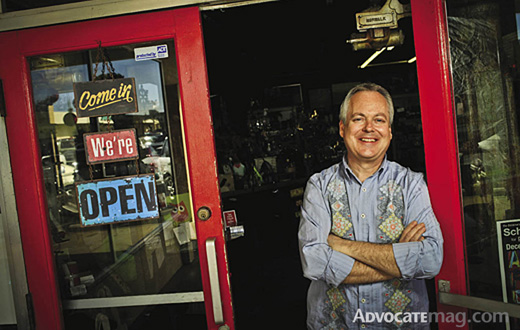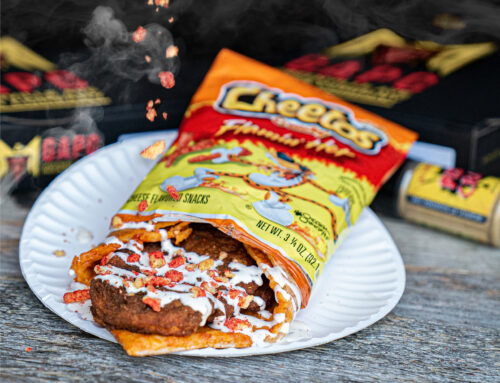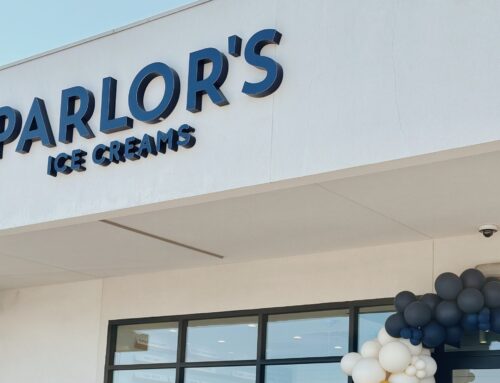The shopping center at Mockingbird and Abrams is making a comeback

ABOVE: Mark Hearne, coowner of Random, which recently opened at Hillside Village, describes his store as a place to buy "locally crafted, handmade, unusual, fun, funky gift ideas." | VIDEO & PHOTOS: By Pulitzer Prize winning photojournalist David Leeson, woven throughout the story below.
The announcement of a local coffee shop opening its second location in Hillside Village was the first indicator of change in the air.
Before White Rock Coffee Express finished construction on its double drive-through kiosk on the northeast corner of Abrams and Mockingbird, two more restaurants had staked claims in the shopping center — Fuzzy’s Taco Shop and Pizzeria Venti. Both hailed themselves as “quick-service” concepts, and both would have patios facing Mockingbird.
Then the dominoes began to fall.
Within a matter of months last year, Hillside Village welcomed seven new tenants, most of them mom-and-pops based in Dallas. All of a sudden, the area referred to as “the shopping center at the northeast corner of Mockingbird and Abrams” once again became known by its original name, the one dubbed by the late Dallas developer W.W. Caruth when he built the shopping center in the mid-’50s.
[youtube]http://www.youtube.com/watch?v=ElrVlzEpKaY[/youtube]Caruth already had developed Inwood Village and Park Cities Village, the strip of shops on Mockinbird west of Central. But Hillside Village was to be his greatest yet, serving a burgeoning area of Dallas that, at the time, was the fastest growing with the highest income bracket. Caruth must have had dollar signs in his eyes as he announced an eventual 300,000 square feet of retail spread across 30 acres north of Mockingbird and spanning both sides of Abrams. The shopping center’s original tenants included “Dallas’ largest supermarket” with a whopping 15,000 square feet, and a slew of neighborhood shops with quaint monikers such as Mrs. Northcutt’s Dress Shop and Fritz’s Paint Store.
Fast-forward five decades, and the picture had changed. The aging center’s anchor stores comprised Dollar Tree, Steinmart and a party supply shop, with Blockbuster, which was quickly becoming a technology dinosaur, occupying prime real estate on the corner of Mockingbird and Hillside.
That was the state of Hillside Village in 2007 when Jim and Rebecca Tudor of Twinrose Investments bought it. The husband-wife team foresaw what was coming — the loss of both Blockbuster and the 25,000-square-foot party supply store in the corner where the much smaller Tuesday Morning now sits.
Losing anchor tenants like these — especially Blockbuster, a mega-corporation that, in the past, guaranteed a substantial rent check each month — could have meant the end of the shopping center’s viability.
In this case, however, it signaled the beginning.
After the coffee shop and two restaurants made their announcements, PK’s Wine and Spirits, a Dallas-based company with locations in Highland Park and Preston Hollow, signed a contract to open its third store in the center.
Random, a boutique selling home décor items, art, antiques and gifts — and owned by 25-year Lakewood residents Shelley and Mark Hearne — moved to the center from Inwood Village.
T. Hee Greetings, a stationery store that originated in Lake Highlands, opened a second location at Hillside Village.
An upscale clothing consigner, Ditto Boutique, relocated from North Dallas.
Tuesday Morning, a longtime Hillside Village fixture, relocated to a corner space with 3,000 square feet of additional breathing room.
“Because of the recession, some tenants that we thought might not make it in the long run went out earlier,” Rebecca Tudor says. “It freed up more space for us to be able to make a bigger impact all at once with tenants that we felt deserved to be in the center and would really serve the neighborhood.”
Before Twinrose bought the shopping center, it had changed ownership three times in fewer than 10 years. The Tudors purchased it with the backing of mostly local investors, and “when we bought it, our investors understood that we felt that this center needed a hands-on owner that would stay with it for a while,” Jim Tudor says. Their goal is for Hillside Village to “be relevant to the neighborhood,” he says.
That’s how the shopping center started out, after all.
“It was really one of the first strip shopping centers for the post-World War II families that were building homes out in the suburbs,” Rebecca Tudor says.
These days, it’s hard to imagine our neighborhood as “the suburbs”, but when it opened in 1955, Hillside Village was intended to be for our neighborhood what a new shopping center is to northern Frisco today, she says.
Now, Hillside Village and shopping centers of its era are experiencing revitalization as real estate investors renovate properties and pursue desirable tenants, says Ian Pierce, director of corporate communications for The Weitzman Group, a commercial retail estate brokerage firm leasing 41 million square feet of retail properties throughout Texas.
“We’re finding that properties inside the loop are seeing a lot of interest, mainly because they do offer the density, and they offer the stability,” Pierce says.
A look at the 3-mile radius around the Mockingbird-Abrams intersection shows a population of 166,452 with 72,576 households and an average household income of $91,450 — “that’s a strong income,” says Pierce, citing Pitney Bowes business insight demographics run through The Weitzman Group.
Those kinds of numbers benefit shops with a more boutique-y feel, Pierce says. Plus, Hillside’s Village original makeup also tends toward mom-and-pop shops because in the 1950s, anchor stores weren’t nearly as large as anchors today.
“Hillside Village doesn’t have a true community center anchor, so it’s more of a neighborhood-type center,” Pierce says.
The other significant demographic is 80,718 — the number of people working in a 3-mile radius of the shopping center during the daytime, “which is really important for restaurants,” Pierce says.
[youtube]http://www.youtube.com/watch?v=Nr7vWFOl11g[/youtube]This helps explain the burgeoning little restaurant scene created by Fuzzy’s and Pizzeria Venti, as well as Lakewood’s 1st and 10 bar and grill, which reopened under local ownership in 2009.
Popular neighborhood eateries are nothing new for the shopping center: In the ’50s and ’60s, it had Charco’s, the hamburger drive-in that was the No. 1 hangout for bobby-socked Woodrow students. Later came Pancho’s Mexican Buffet.
The original occupant of the Tuesday Morning corner space was Reed Hardware, “a really good hardware store” which was owned by three siblings, says Sue Sinclair of Lakewood Lighting, who has been in business at Hillside for 33 years. And Jim Tudor fondly recalls visiting Jo Jo Toys as a child when his mother took him along on errands to Hillside Village.
In the decades since Charco’s, Reed and Jo Jo, many mom-and-pops gave way to national corporations, such as the Drug Emporium that took over the Reed Hardware space. Then as the center aged, it became more attractive to discount retailers looking for a deal on prime real estate in urban areas.
When Twinrose took over, the Tudors determined to be more selective about tenants, which for them meant turning down some of the discount retailers that came calling.
“The neighborhood still wants discount [stores] to be available to them, but I think that there was a shortage of tenants that were just a little more eclectic,” Rebecca Tudor says.
A drive-through coffee shop was on the wish list, and Jim Tudor knew White Rock Coffee owner Nancy Baker from their high school days. When he called her, he learned that the business was looking to expand.
“Things on the east side and north side of the lake are connected in attitude, so it was a logical extension for them to move to that intersection,” he says.
At the top of Twinrose’s list were restaurants, and to make that happen, “we were very patient with what we put into a space,” Jim Tudor says. “We really wanted some restaurants to put on the street, but we didn’t take the first restaurant that came along, and we didn’t take things that weren’t restaurants.”
The restaurants needed to be able to utilize patios and appeal to not only residents of the immediate Lakewood area “but also a youthful customer that comes from a fairly wide area around that intersection,” he says. “Certainly, Fuzzy’s matches that. People who have never been to our center will eat there, and then notice other stuff.”
That’s why the Tudors wanted to place the restaurant’s main door on the west side, encouraging people to park in the core of the shopping center. So when the taco shop has lines every day for lunch and is crowded on weekends from open ’til close, customers are more likely to notice the shoe repair shop next door, which should result in more business.
And it has. Heather Green, who co-owns Rico Hillside Shoe Service with her husband, Francisco Rico, says their shop is getting new business because of restaurant and retail traffic.
[youtube]http://www.youtube.com/watch?v=lYmmQHOpjVw[/youtube]“The shopping center is always full, so it attracts attention to other businesses that have been around awhile.”
Adding casual restaurants with patios on that corner has pushed the retail center into a new era, the Tudors say. It’s a focal point that draws people driving or cycling to and from White Rock Lake. Brokers have begun paying attention, too — the Twinrose phones ring every day with calls about the center, they say.
That’s good news for the investors, who regularly contact the Tudors with their two cents.
“Some of our investors live in Lakewood, and many of them live in the city of Dallas,” Rebecca Tudor says. “They shop at this property, and they call us and tell us what they like and don’t like. It really makes it much more personal.”
The local ownership contributes to the retail strategy, such as the push to open the shopping center to more local entrepreneurs. Judging by the profile of new tenants, that strategy has been successful.
But luck also played a part in the shopping center’s recent revival. And in Hillside Village’s case, luck showed up in the form of an unlikely helper — the recession.
Visitors to Hillside Village may attest to the center being busier now than it was three or four years ago.
“Some of my customers have a hard time finding a parking space,” says Cindy Taylor, who owns Hillside Beauty Salon, which opened with the center in the ’50s.
But the shopping center is 86 percent leased today, compared to 100 percent leased when Twinrose purchased it. However, only 19 of the 34 tenants occupying the center in 2007 still remain. Many of the stores that vacated “were just a casualty of the economy,” Rebecca Tudor says, “and allowed us to accelerate our plan, which was to re-tenant it slightly over time.”
New retail construction screeched to a halt after the 2008 bank failures, and Twinrose waited out 2009, which “was just not a leasing year,” Jim Tudor says. By the following year, however, retailers and restaurants had begun focusing on existing shopping centers with open space.
The result at Hillside Village was “lemonade out of lemons,” Rebecca Tudor says.
They squeezed more small-business space out of the center as part of the transition. Roughly half of the party supply store became Tuesday Morning; the other half was divided into two spaces that may someday become a bike shop or some sort of furnishings store, Jim Tudor says, or perhaps be split up into multiple service shops. The original 9,500-square-foot-Tuesday Morning space will eventually be carved into multiple spaces, too, they say, just like the single Blockbuster store became three spaces.
Large spaces are usually sought after by large companies, which have an easier time paying the corresponding rent. But national companies have become less aggressive because of the recession. And in a central city area such as our neighborhood, the value of space goes up, Jim Tudor says, and “there are a lot more local tenants that can get into a location if you make it smaller.”
[youtube]http://www.youtube.com/watch?v=TevrtHx0gUo[/youtube]The Weitzman Group has leased several former Blockbuster spaces, and “there definitely is a trend to reworking some of these spaces” with more than one tenant, Pierce says.
The former Blockbuster space in Hillside Village is “right there on the street, great visibility,” Pierce says. “A lot of those Blockbuster spaces tended to be one of the best spaces in any given shopping center, which explains why you’re seeing some really strong tenants backfill them.”
Smaller tenants also give Hillside Village “more diverse offerings, a little more congestion,” and “a much more urban feel,” Rebecca Tudor says.
Certainly, the Tudors and other Hillside investors are pleased with what has happened in such a short amount of time, especially considering how some other real estate investors have fared in recent years. But “we do still consider it a work in progress,” Jim Tudor says. Twinrose is interested in one more restaurant adjacent to either Abrams or Mockingbird and is on the lookout for other shops that would bring something new to the center.
“We’re trying to anticipate not just where Lakewood and Lake Highlands and the Greater East Dallas area is today,” Rebecca Tudor says, “but where it is going to be in 20 years.”
BLAST TO THE PAST
Hillside Village in 1950s news
“CONSTRUCTION STARTS THURSDAY ON HUGE NORTH DALLAS CENTER”
Dallas Morning News, June 27, 1954
Hillside Village was announced as “the largest shopping center in North Dallas or the Park Cities under one ownership, developer W.W. Caruth Jr.” The original village was built on both sides of Abrams north of Mockingbird (the west side of Mockingbird is now called Mockingbird Commons), and included 300,000 square feet of space plus parking. The larger section on the east side was built to accommodate 35 stores, including two supermarkets, a large independent drug store, and a super service station on the corner.
The area around Hillside Village was “in the highest income bracket in Greater Dallas, and one of the fastest growing,” according to the U.S. Bureau of the Census. Caruth estimated that the village would eventually serve 25,000 area residents north to Northwest Highway and east to White Rock Lake.
“HILLSIDE TO OBSERVE FIRST YEAR”
Dallas Morning News, April 12, 1956
Hillside Village’s 30 merchants celebrated the shopping center’s first anniversary in April 1956 with a Saturday night drawing of merchant prizes, each worth $25 or more. The prizes ranged “from paint to mattresses, from movie cameras to ice cream.” Within the first year, the stores were spread over 12 acres with 130,000 square feet of retail space, and T.B. Timbs, assistant to Hillside developer W.W. Caruth, noted that “to date, there are no building vacancies in the center.”
Hillside Village businesses participating in the celebration included: John Cobb’s Hillside Village Drugs; Fritz’s Paint Store, Community Sewing Shop; Direct Mattress Company; A&P Super Market; Owens Brothers Jewelry; Super Tex Camera Store; Ches-Lee; Conkling’s Youth Fashions; Davenport’s 5 cents to $1 Store; Home’s Hillside Store; Williams-Logue Carpets; Reed Hardware; Beck’s Fried Chicken; Village Man’s Shop; Polly Dupont; Clinton’s Shoes; Jo Jo Toys; Flowers Galore and Garden Center; Ford’s Ben Franklin Store; Hillside Village Barbers; Linda’s Beauty Shop; Evan’s Food Mart No. 2; Lee’s Television-Records Shop; Eames Ice Cream; Village Grill & Restaurant; White Star Laundry; Drew’s Supermarket; Pat Carbone’s Humble Station; and Mrs. Northcutt’s Dress Shop.
“CITY’S BIGGEST SUPERMARKET SCHEDULES OPENING TODAY”
Dallas Morning News, March 1, 1955
When Hillside Village A&P opened in the shopping center, it was “Dallas’ largest supermarket” at the time with 15,000 square feet. The new store was “designed to serve shoppers west of White Rock Lake and in the Lakewood, Skillman and Greenville Avenue neighborhoods.”
“CARUTH SCHEDULED TO OPEN HILLSIDE”
Dallas Morning News, March 31, 1955
When Caruth envisioned Hillside Village, he had already developed Inwood Village and Park Cities Village on Mockingbird at Central. A profile on Caruth soon after Hillside opened noted that “his Inwood Village has long been regarded as a model among the nation’s shopping centers, and in 1952 his Park Cities Village won the national award from the home builders’ organization.” When completed, Hillside Village was “expected to surpass any of the others in size and perfection because of improvements dictated by knowledge gained from the development of the earlier shopping centers.”
The profile also describes Caruth as “a champion of proper zoning” but “he nevertheless realizes that too often certain zoning legislation is enacted with little forethought to its eventual effect on development of specific areas within a community, and sometimes, development of the community itself.”





